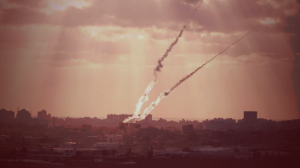One of the biggest sources of dissatisfaction among the Israeli public during Israel’s last major armed conflict, the 2014 clash with Hamas, was the length of hostilities.
Lasting 50 days, Operation Protective Edge turned out to be one of the most prolonged conflicts in Israel’s military history, and this was not because the warring sides were evenly matched.
Despite Israel’s military superiority, Hamas fired rockets at the Israeli home front daily, shelled southern communities, and its guerrilla forces launched hit-and run attacks on Israel Defense Forces (IDF) in both Gaza and southern Israel, right up to the last day of the operation.

This, despite the fact that Israel leveled devastating strikes on Hamas and Palestinian Islamic Jihad, killing over 1000 enemy combatants, destroying most of Hamas’s tunnels, and leaving its bases of operations – which were embedded in civilian areas – in ruins.
The Israeli public, even those born many years after the 1967 Six Day War, expects Israel to move more quickly to defeat its enemies when under threat. Some often conjure up the lightening victory achieved by Israel against three large and well armed Arab armies fifty years ago, and hold it as the standard that should guide the IDF and government today.
Domestic critics of the 2014 conflict call up the Six Day War as a standard of correct military obectives: Take the war to the enemy, use overwhelming force, and achieve a clear victory picture – in as little time as possible.
Yet such criticisms often overlook the fact that soon after the end of the Six Day War, a new armed conflict began between Israel and some of its enemies – Egypt and the PLO. This was the War of Attrition, and it drew on for no less than three years.
The War of Attrition, initiated by Egypt, began with a series of provocations, starting with the sinking of an Israeli Navy boat in 1967, just 4 months after the end of the Six Day War. The Israel Air Force bombed a target in Suez in retaliation. The tit for tat blows escalated with time. The conflict ended up claiming nearly 1,000 Israeli casualties, and Arab casualties were several times higher.
Artillery battles along the Suez Canal, and limited cross-border commando incursions by Egypt against Israeli positions in the Sinai, developed, over time, into large-scale air battles. Battles at sea between navies also raged.
Israel launched air strikes deep inside Egypt, and IDF commandos launched retaliation raids on Egyptian targets. The IDF battled PLO guerrilla raids from Jordan as well.

The War of Attrition often fails to enter into the 1967 narrative.
Those using the Six Day War as a standard tend to overlook the War of Attrition, because it does not necessarily fit the narrative of a swift and convincing victory.
The reality is that Israel has never achieved a total victory over its enemies, as this can only be accomplished by utterly destroying the countries from which they come.
But Israel has always succeeded in causing its enemies sufficient damage to punctuate waves of all-out conflict with periods of lower intensity exchanges, or truces. Eventually, old enemies gave up the idea of destroying Israel on the battlefield, and signed peace treaties with Israel. New enemies took their place.
In the 20th century, the damage absorbed by Israel’s enemies gave them pause and removed their desire to keep attacking. It did not stop them from rebuilding their armies, rearming, and preparing for the next round.
In the modern era of non-state actor enemies, this pattern has held up. Israel’s conflicts with Hezbollah and Hamas have not resulted in the all-out destruction of these jihadist armies, but in sufficient damage being leveled for them to hold their fire for years.
And yet, despite all of the above, the next war with Hezbollah or Hamas could see the IDF attempt to return to a ‘Six Day War’ type victory picture.
In an age when jihadist forces are intent on targeting Israel’s soft underbelly – the home front – with rockets and missiles, the idea of future wars dragging on for many weeks or months is becoming untenable.
The objective of a fast victory, using overwhelming force, has therefore made a comeback.
The added twist is that the objective of utterly destroying the enemy is more attainable for Israel today than it has ever been in the past.
This is due to advances in ground offensive capabilities, which make Israeli armored formations an unstoppable force in the Middle East, and major increases in the Israel Air Force’s target destruction rate.
These, combined with the revolution in network-centric warfare, and Israel’s unrivaled intelligence capabilities, means that Israel today has the option of laying waste a foe like Hezbollah, and eliminate it as a fighting force for many years – despite the fact that Hezbollah’s arsenal is enormous and poses a major threat.
Lebanon, as a weak state that hosts Hezbollah, would suffer greatly, and could itself become a failed state in such a scenario.
The associated question of whether the Israeli government would order the IDF to carry out such an objective is tied in to the question of how much pressure the Israeli home front would be under, in the event of a future conflict. Ironically, the bigger the threat Hezbollah poses, the more likely it is that the government of Israel would feel compelled to act with full force in the event of a conflict.
Hezbollah’s enormous surface-to- surface rocket and missile arsenal would place Israeli cities, towns, and villages under fire to an extent never before seen.
The outcry and pressure from Israeli citizens would likely be massive enough to leave the government with little choice but to activate the IDF’s fullest offensive capabilities. Another impetus for Israel to achieve victory quickly would be the time limit the international community, led by the US, might impose on such a destructive war.
For now, Israel’s growing capabilities are contributing to strong deterrence against its foes, and deterrence helps keep open conflict away.
The best scenario is for all sides to continue to avoid the horrors war, for as long as possible.
But if Israel is forced to defend itself against belligerent Islamist entities, the Six Day War standard may shape Israel’s future war objectives, and the objective this time might be to ensure that no ‘War of Attrition 2’ would follow.
What are the major advances in the IDF’s ground offensive capabilities and why or how has the air target destruction rate increased?
Armored vehicles – tanks and APCs – have Rafael’s Trophy installed, immunizing them against shoulder-fired missiles and RPGs. It’s an active protection system that intercepts incoming threats to armored vehicles.
IAF doesn’t talk much about how it increased the rate, but it makes it very clear that it did. See here for further details: https://yaakovlappin.com/the-israel-air-forces-force-build-up-program-waves-of-massive-heavy-fire/
Tx, appreciate the response, very informative.